Positive Leadership: Fostering Wellness for Nurses in Healthcare
VerifiedAdded on 2023/04/26
|9
|2097
|245
Essay
AI Summary
This essay discusses the concept of positive leadership and its importance in the healthcare industry, particularly in fostering the wellbeing and productivity of nurses. It highlights that positive leaders can motivate and guide individuals toward a shared vision, using positive reinforcements to improve performance. The essay emphasizes the stressful nature of healthcare environments and the potential impact on the mental health of healthcare workers, particularly nurses. It suggests that strategies such as skill development programs, wellness initiatives, and positive reinforcement through rewards and recognition can significantly improve employee wellbeing and productivity. The essay concludes that positive leadership is crucial for leading healthcare workers towards better performance and service quality, and that continuous improvement programs are essential for maintaining a positive and productive work environment.
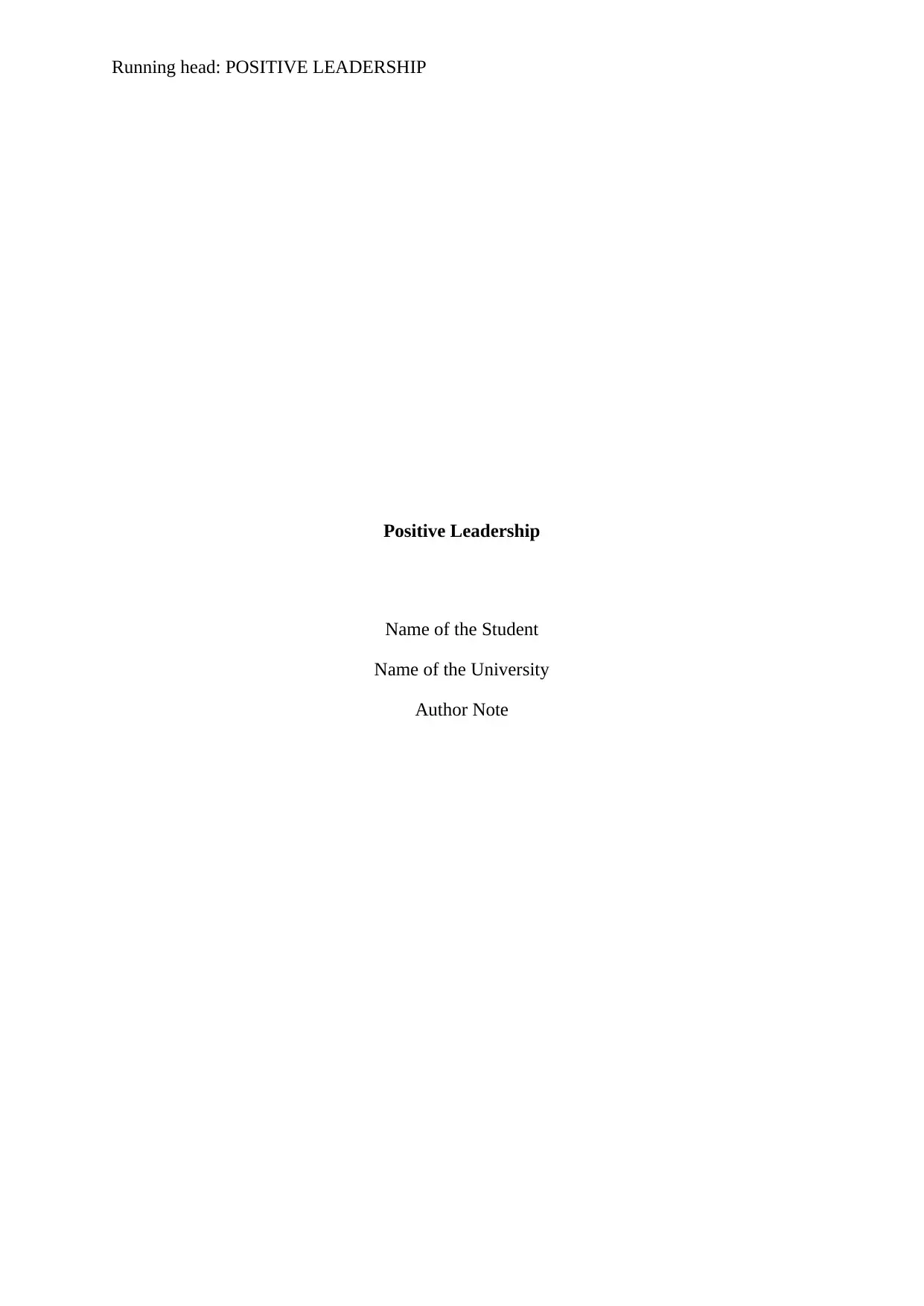
Running head: POSITIVE LEADERSHIP
Positive Leadership
Name of the Student
Name of the University
Author Note
Positive Leadership
Name of the Student
Name of the University
Author Note
Paraphrase This Document
Need a fresh take? Get an instant paraphrase of this document with our AI Paraphraser
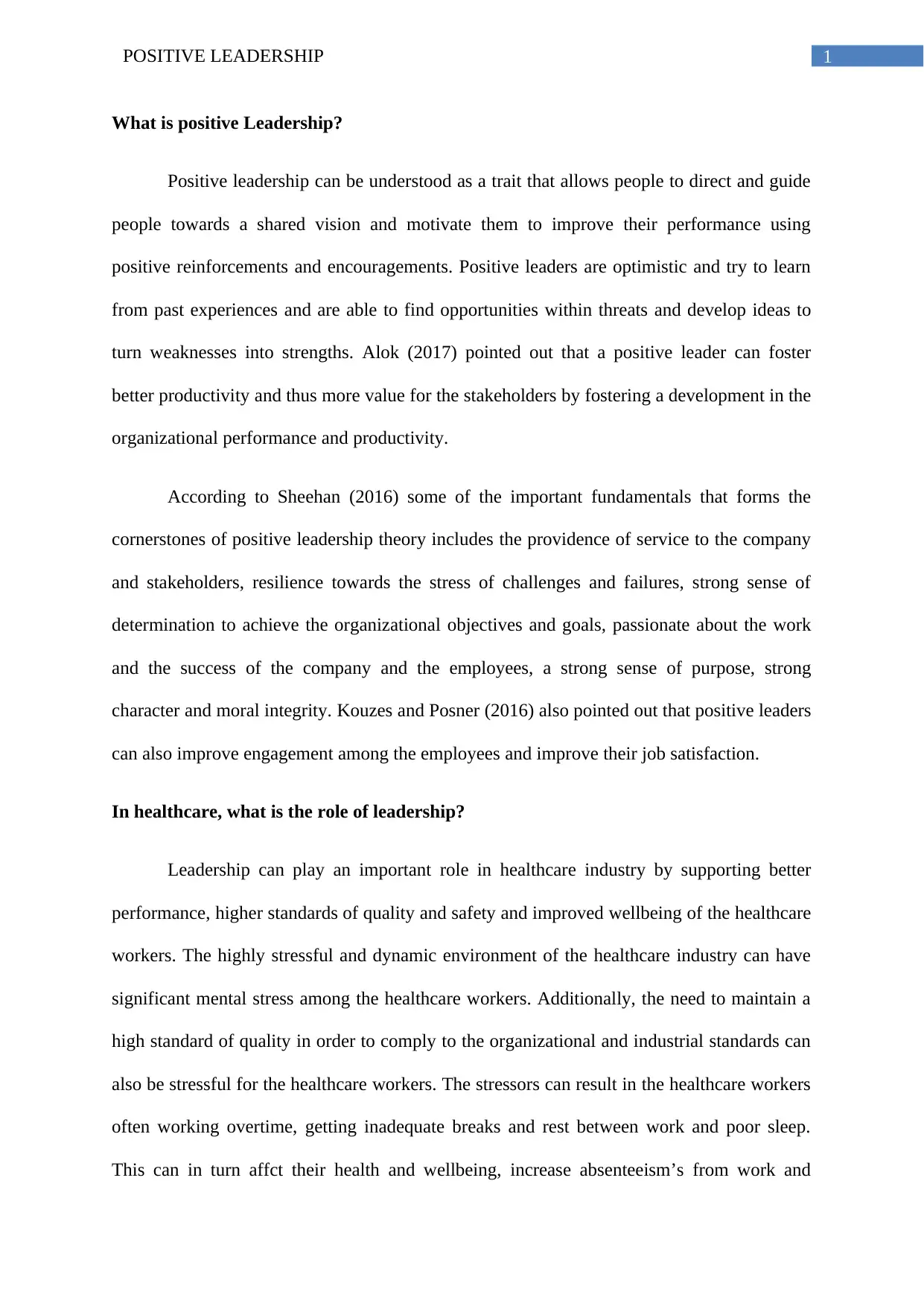
1POSITIVE LEADERSHIP
What is positive Leadership?
Positive leadership can be understood as a trait that allows people to direct and guide
people towards a shared vision and motivate them to improve their performance using
positive reinforcements and encouragements. Positive leaders are optimistic and try to learn
from past experiences and are able to find opportunities within threats and develop ideas to
turn weaknesses into strengths. Alok (2017) pointed out that a positive leader can foster
better productivity and thus more value for the stakeholders by fostering a development in the
organizational performance and productivity.
According to Sheehan (2016) some of the important fundamentals that forms the
cornerstones of positive leadership theory includes the providence of service to the company
and stakeholders, resilience towards the stress of challenges and failures, strong sense of
determination to achieve the organizational objectives and goals, passionate about the work
and the success of the company and the employees, a strong sense of purpose, strong
character and moral integrity. Kouzes and Posner (2016) also pointed out that positive leaders
can also improve engagement among the employees and improve their job satisfaction.
In healthcare, what is the role of leadership?
Leadership can play an important role in healthcare industry by supporting better
performance, higher standards of quality and safety and improved wellbeing of the healthcare
workers. The highly stressful and dynamic environment of the healthcare industry can have
significant mental stress among the healthcare workers. Additionally, the need to maintain a
high standard of quality in order to comply to the organizational and industrial standards can
also be stressful for the healthcare workers. The stressors can result in the healthcare workers
often working overtime, getting inadequate breaks and rest between work and poor sleep.
This can in turn affct their health and wellbeing, increase absenteeism’s from work and
What is positive Leadership?
Positive leadership can be understood as a trait that allows people to direct and guide
people towards a shared vision and motivate them to improve their performance using
positive reinforcements and encouragements. Positive leaders are optimistic and try to learn
from past experiences and are able to find opportunities within threats and develop ideas to
turn weaknesses into strengths. Alok (2017) pointed out that a positive leader can foster
better productivity and thus more value for the stakeholders by fostering a development in the
organizational performance and productivity.
According to Sheehan (2016) some of the important fundamentals that forms the
cornerstones of positive leadership theory includes the providence of service to the company
and stakeholders, resilience towards the stress of challenges and failures, strong sense of
determination to achieve the organizational objectives and goals, passionate about the work
and the success of the company and the employees, a strong sense of purpose, strong
character and moral integrity. Kouzes and Posner (2016) also pointed out that positive leaders
can also improve engagement among the employees and improve their job satisfaction.
In healthcare, what is the role of leadership?
Leadership can play an important role in healthcare industry by supporting better
performance, higher standards of quality and safety and improved wellbeing of the healthcare
workers. The highly stressful and dynamic environment of the healthcare industry can have
significant mental stress among the healthcare workers. Additionally, the need to maintain a
high standard of quality in order to comply to the organizational and industrial standards can
also be stressful for the healthcare workers. The stressors can result in the healthcare workers
often working overtime, getting inadequate breaks and rest between work and poor sleep.
This can in turn affct their health and wellbeing, increase absenteeism’s from work and
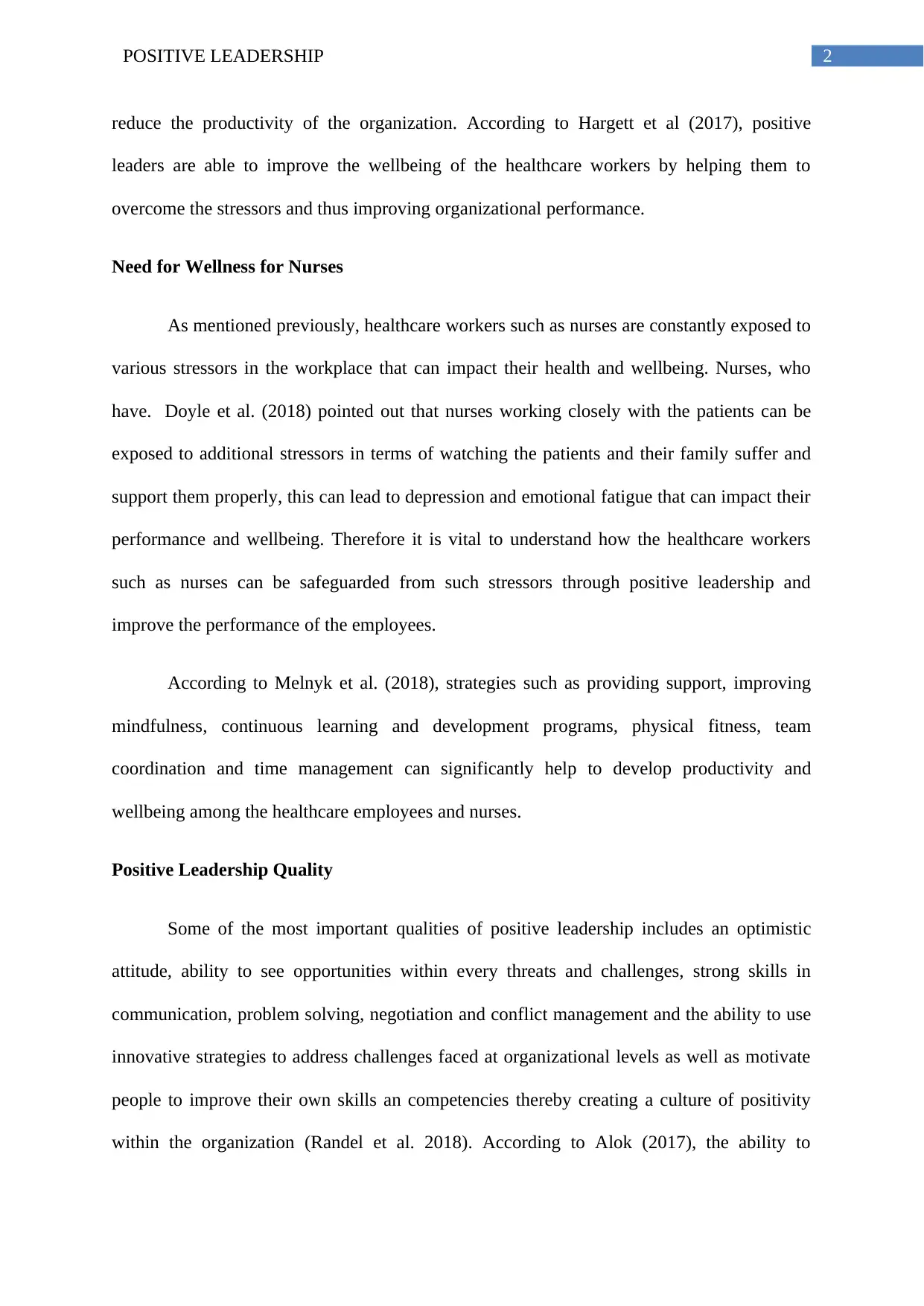
2POSITIVE LEADERSHIP
reduce the productivity of the organization. According to Hargett et al (2017), positive
leaders are able to improve the wellbeing of the healthcare workers by helping them to
overcome the stressors and thus improving organizational performance.
Need for Wellness for Nurses
As mentioned previously, healthcare workers such as nurses are constantly exposed to
various stressors in the workplace that can impact their health and wellbeing. Nurses, who
have. Doyle et al. (2018) pointed out that nurses working closely with the patients can be
exposed to additional stressors in terms of watching the patients and their family suffer and
support them properly, this can lead to depression and emotional fatigue that can impact their
performance and wellbeing. Therefore it is vital to understand how the healthcare workers
such as nurses can be safeguarded from such stressors through positive leadership and
improve the performance of the employees.
According to Melnyk et al. (2018), strategies such as providing support, improving
mindfulness, continuous learning and development programs, physical fitness, team
coordination and time management can significantly help to develop productivity and
wellbeing among the healthcare employees and nurses.
Positive Leadership Quality
Some of the most important qualities of positive leadership includes an optimistic
attitude, ability to see opportunities within every threats and challenges, strong skills in
communication, problem solving, negotiation and conflict management and the ability to use
innovative strategies to address challenges faced at organizational levels as well as motivate
people to improve their own skills an competencies thereby creating a culture of positivity
within the organization (Randel et al. 2018). According to Alok (2017), the ability to
reduce the productivity of the organization. According to Hargett et al (2017), positive
leaders are able to improve the wellbeing of the healthcare workers by helping them to
overcome the stressors and thus improving organizational performance.
Need for Wellness for Nurses
As mentioned previously, healthcare workers such as nurses are constantly exposed to
various stressors in the workplace that can impact their health and wellbeing. Nurses, who
have. Doyle et al. (2018) pointed out that nurses working closely with the patients can be
exposed to additional stressors in terms of watching the patients and their family suffer and
support them properly, this can lead to depression and emotional fatigue that can impact their
performance and wellbeing. Therefore it is vital to understand how the healthcare workers
such as nurses can be safeguarded from such stressors through positive leadership and
improve the performance of the employees.
According to Melnyk et al. (2018), strategies such as providing support, improving
mindfulness, continuous learning and development programs, physical fitness, team
coordination and time management can significantly help to develop productivity and
wellbeing among the healthcare employees and nurses.
Positive Leadership Quality
Some of the most important qualities of positive leadership includes an optimistic
attitude, ability to see opportunities within every threats and challenges, strong skills in
communication, problem solving, negotiation and conflict management and the ability to use
innovative strategies to address challenges faced at organizational levels as well as motivate
people to improve their own skills an competencies thereby creating a culture of positivity
within the organization (Randel et al. 2018). According to Alok (2017), the ability to
⊘ This is a preview!⊘
Do you want full access?
Subscribe today to unlock all pages.

Trusted by 1+ million students worldwide
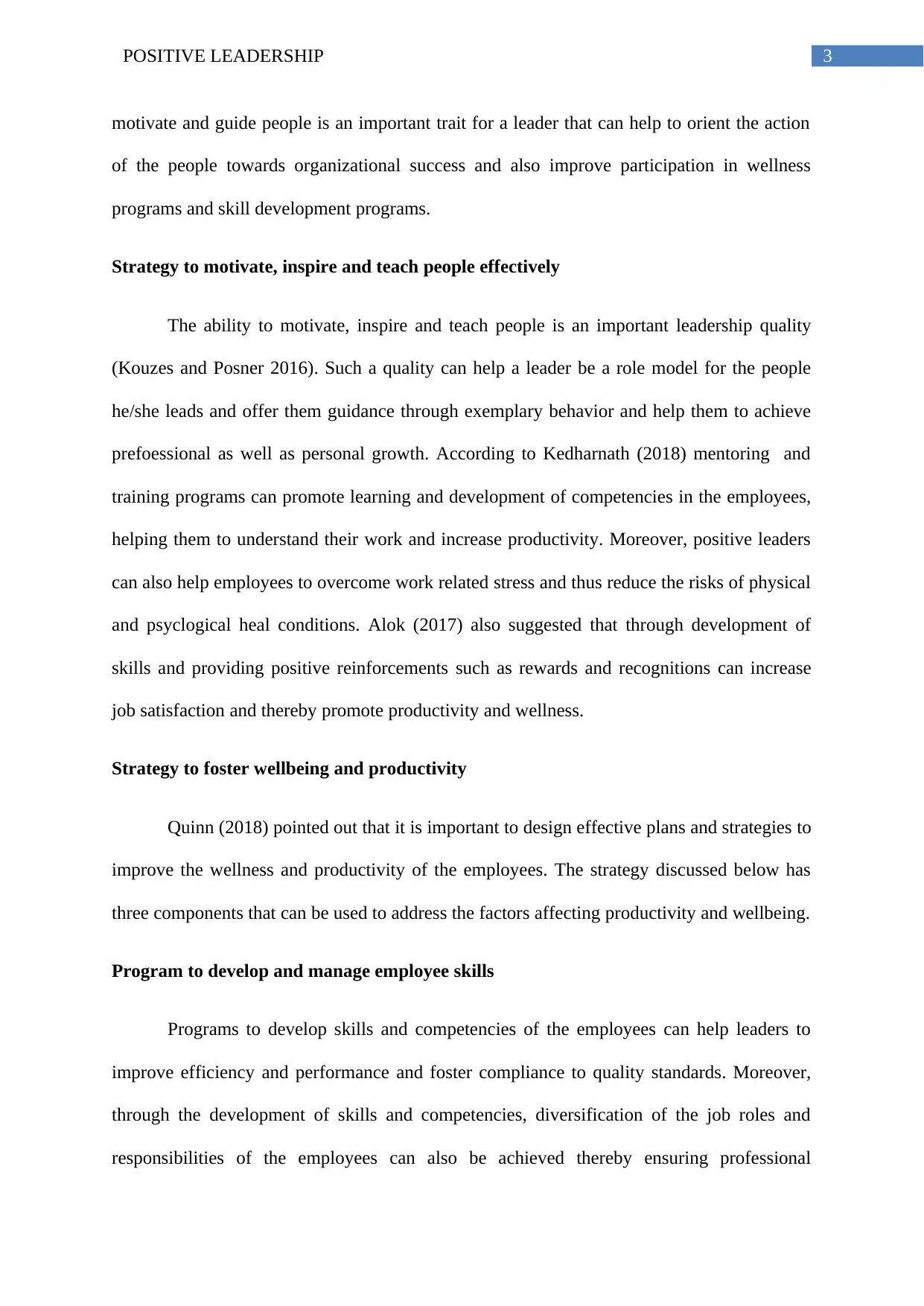
3POSITIVE LEADERSHIP
motivate and guide people is an important trait for a leader that can help to orient the action
of the people towards organizational success and also improve participation in wellness
programs and skill development programs.
Strategy to motivate, inspire and teach people effectively
The ability to motivate, inspire and teach people is an important leadership quality
(Kouzes and Posner 2016). Such a quality can help a leader be a role model for the people
he/she leads and offer them guidance through exemplary behavior and help them to achieve
prefoessional as well as personal growth. According to Kedharnath (2018) mentoring and
training programs can promote learning and development of competencies in the employees,
helping them to understand their work and increase productivity. Moreover, positive leaders
can also help employees to overcome work related stress and thus reduce the risks of physical
and psyclogical heal conditions. Alok (2017) also suggested that through development of
skills and providing positive reinforcements such as rewards and recognitions can increase
job satisfaction and thereby promote productivity and wellness.
Strategy to foster wellbeing and productivity
Quinn (2018) pointed out that it is important to design effective plans and strategies to
improve the wellness and productivity of the employees. The strategy discussed below has
three components that can be used to address the factors affecting productivity and wellbeing.
Program to develop and manage employee skills
Programs to develop skills and competencies of the employees can help leaders to
improve efficiency and performance and foster compliance to quality standards. Moreover,
through the development of skills and competencies, diversification of the job roles and
responsibilities of the employees can also be achieved thereby ensuring professional
motivate and guide people is an important trait for a leader that can help to orient the action
of the people towards organizational success and also improve participation in wellness
programs and skill development programs.
Strategy to motivate, inspire and teach people effectively
The ability to motivate, inspire and teach people is an important leadership quality
(Kouzes and Posner 2016). Such a quality can help a leader be a role model for the people
he/she leads and offer them guidance through exemplary behavior and help them to achieve
prefoessional as well as personal growth. According to Kedharnath (2018) mentoring and
training programs can promote learning and development of competencies in the employees,
helping them to understand their work and increase productivity. Moreover, positive leaders
can also help employees to overcome work related stress and thus reduce the risks of physical
and psyclogical heal conditions. Alok (2017) also suggested that through development of
skills and providing positive reinforcements such as rewards and recognitions can increase
job satisfaction and thereby promote productivity and wellness.
Strategy to foster wellbeing and productivity
Quinn (2018) pointed out that it is important to design effective plans and strategies to
improve the wellness and productivity of the employees. The strategy discussed below has
three components that can be used to address the factors affecting productivity and wellbeing.
Program to develop and manage employee skills
Programs to develop skills and competencies of the employees can help leaders to
improve efficiency and performance and foster compliance to quality standards. Moreover,
through the development of skills and competencies, diversification of the job roles and
responsibilities of the employees can also be achieved thereby ensuring professional
Paraphrase This Document
Need a fresh take? Get an instant paraphrase of this document with our AI Paraphraser
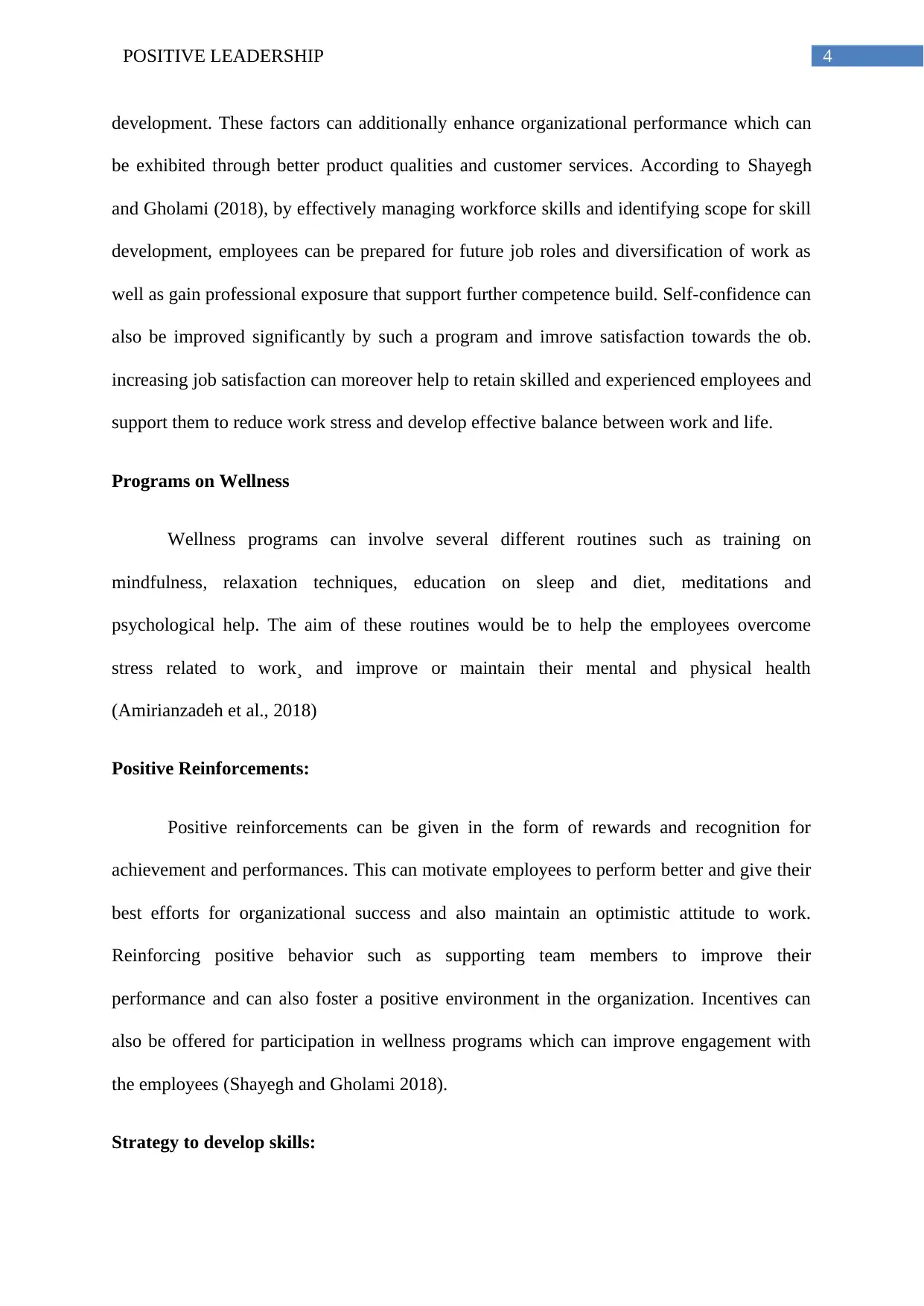
4POSITIVE LEADERSHIP
development. These factors can additionally enhance organizational performance which can
be exhibited through better product qualities and customer services. According to Shayegh
and Gholami (2018), by effectively managing workforce skills and identifying scope for skill
development, employees can be prepared for future job roles and diversification of work as
well as gain professional exposure that support further competence build. Self-confidence can
also be improved significantly by such a program and imrove satisfaction towards the ob.
increasing job satisfaction can moreover help to retain skilled and experienced employees and
support them to reduce work stress and develop effective balance between work and life.
Programs on Wellness
Wellness programs can involve several different routines such as training on
mindfulness, relaxation techniques, education on sleep and diet, meditations and
psychological help. The aim of these routines would be to help the employees overcome
stress related to work¸ and improve or maintain their mental and physical health
(Amirianzadeh et al., 2018)
Positive Reinforcements:
Positive reinforcements can be given in the form of rewards and recognition for
achievement and performances. This can motivate employees to perform better and give their
best efforts for organizational success and also maintain an optimistic attitude to work.
Reinforcing positive behavior such as supporting team members to improve their
performance and can also foster a positive environment in the organization. Incentives can
also be offered for participation in wellness programs which can improve engagement with
the employees (Shayegh and Gholami 2018).
Strategy to develop skills:
development. These factors can additionally enhance organizational performance which can
be exhibited through better product qualities and customer services. According to Shayegh
and Gholami (2018), by effectively managing workforce skills and identifying scope for skill
development, employees can be prepared for future job roles and diversification of work as
well as gain professional exposure that support further competence build. Self-confidence can
also be improved significantly by such a program and imrove satisfaction towards the ob.
increasing job satisfaction can moreover help to retain skilled and experienced employees and
support them to reduce work stress and develop effective balance between work and life.
Programs on Wellness
Wellness programs can involve several different routines such as training on
mindfulness, relaxation techniques, education on sleep and diet, meditations and
psychological help. The aim of these routines would be to help the employees overcome
stress related to work¸ and improve or maintain their mental and physical health
(Amirianzadeh et al., 2018)
Positive Reinforcements:
Positive reinforcements can be given in the form of rewards and recognition for
achievement and performances. This can motivate employees to perform better and give their
best efforts for organizational success and also maintain an optimistic attitude to work.
Reinforcing positive behavior such as supporting team members to improve their
performance and can also foster a positive environment in the organization. Incentives can
also be offered for participation in wellness programs which can improve engagement with
the employees (Shayegh and Gholami 2018).
Strategy to develop skills:
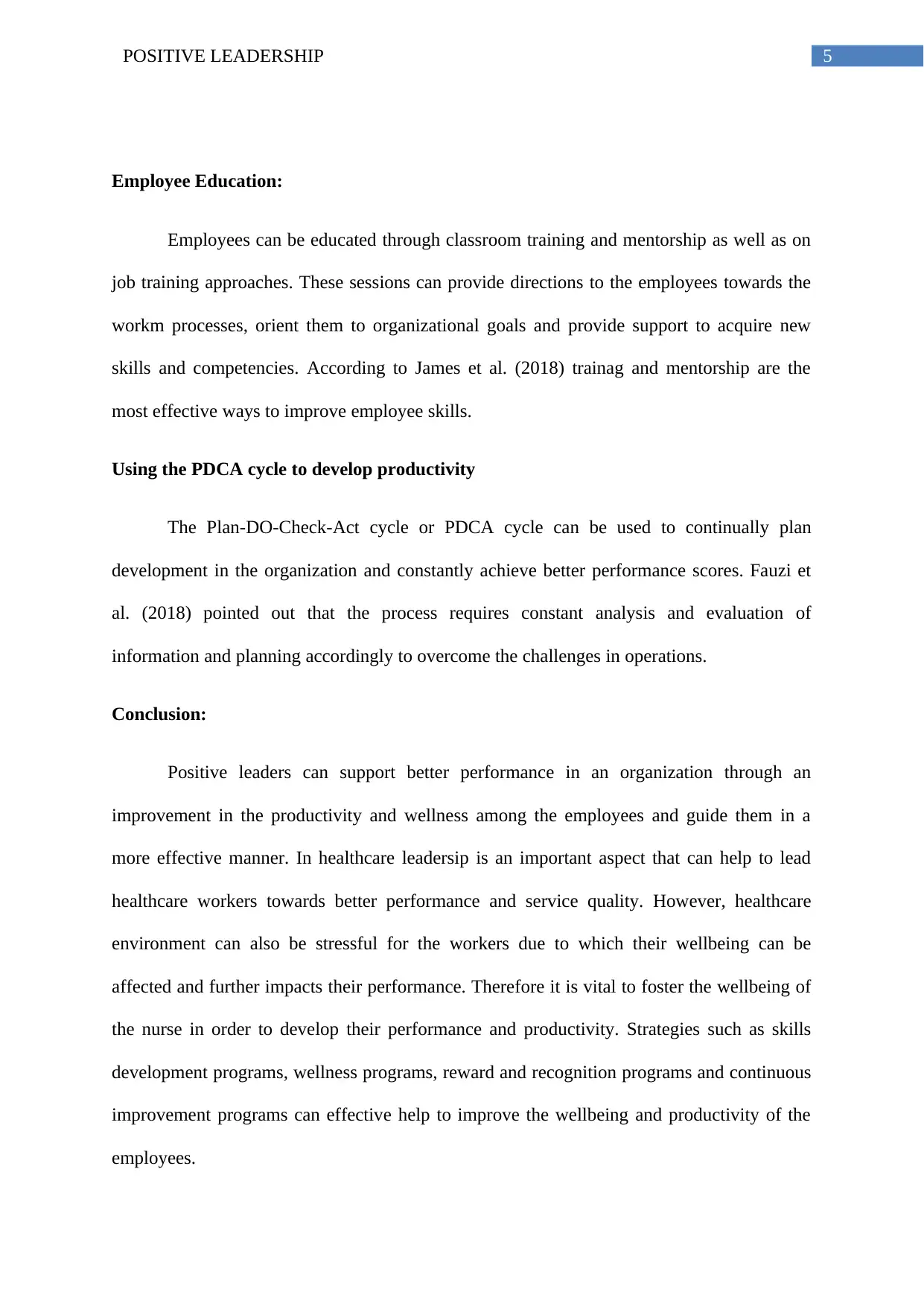
5POSITIVE LEADERSHIP
Employee Education:
Employees can be educated through classroom training and mentorship as well as on
job training approaches. These sessions can provide directions to the employees towards the
workm processes, orient them to organizational goals and provide support to acquire new
skills and competencies. According to James et al. (2018) trainag and mentorship are the
most effective ways to improve employee skills.
Using the PDCA cycle to develop productivity
The Plan-DO-Check-Act cycle or PDCA cycle can be used to continually plan
development in the organization and constantly achieve better performance scores. Fauzi et
al. (2018) pointed out that the process requires constant analysis and evaluation of
information and planning accordingly to overcome the challenges in operations.
Conclusion:
Positive leaders can support better performance in an organization through an
improvement in the productivity and wellness among the employees and guide them in a
more effective manner. In healthcare leadersip is an important aspect that can help to lead
healthcare workers towards better performance and service quality. However, healthcare
environment can also be stressful for the workers due to which their wellbeing can be
affected and further impacts their performance. Therefore it is vital to foster the wellbeing of
the nurse in order to develop their performance and productivity. Strategies such as skills
development programs, wellness programs, reward and recognition programs and continuous
improvement programs can effective help to improve the wellbeing and productivity of the
employees.
Employee Education:
Employees can be educated through classroom training and mentorship as well as on
job training approaches. These sessions can provide directions to the employees towards the
workm processes, orient them to organizational goals and provide support to acquire new
skills and competencies. According to James et al. (2018) trainag and mentorship are the
most effective ways to improve employee skills.
Using the PDCA cycle to develop productivity
The Plan-DO-Check-Act cycle or PDCA cycle can be used to continually plan
development in the organization and constantly achieve better performance scores. Fauzi et
al. (2018) pointed out that the process requires constant analysis and evaluation of
information and planning accordingly to overcome the challenges in operations.
Conclusion:
Positive leaders can support better performance in an organization through an
improvement in the productivity and wellness among the employees and guide them in a
more effective manner. In healthcare leadersip is an important aspect that can help to lead
healthcare workers towards better performance and service quality. However, healthcare
environment can also be stressful for the workers due to which their wellbeing can be
affected and further impacts their performance. Therefore it is vital to foster the wellbeing of
the nurse in order to develop their performance and productivity. Strategies such as skills
development programs, wellness programs, reward and recognition programs and continuous
improvement programs can effective help to improve the wellbeing and productivity of the
employees.
⊘ This is a preview!⊘
Do you want full access?
Subscribe today to unlock all pages.

Trusted by 1+ million students worldwide
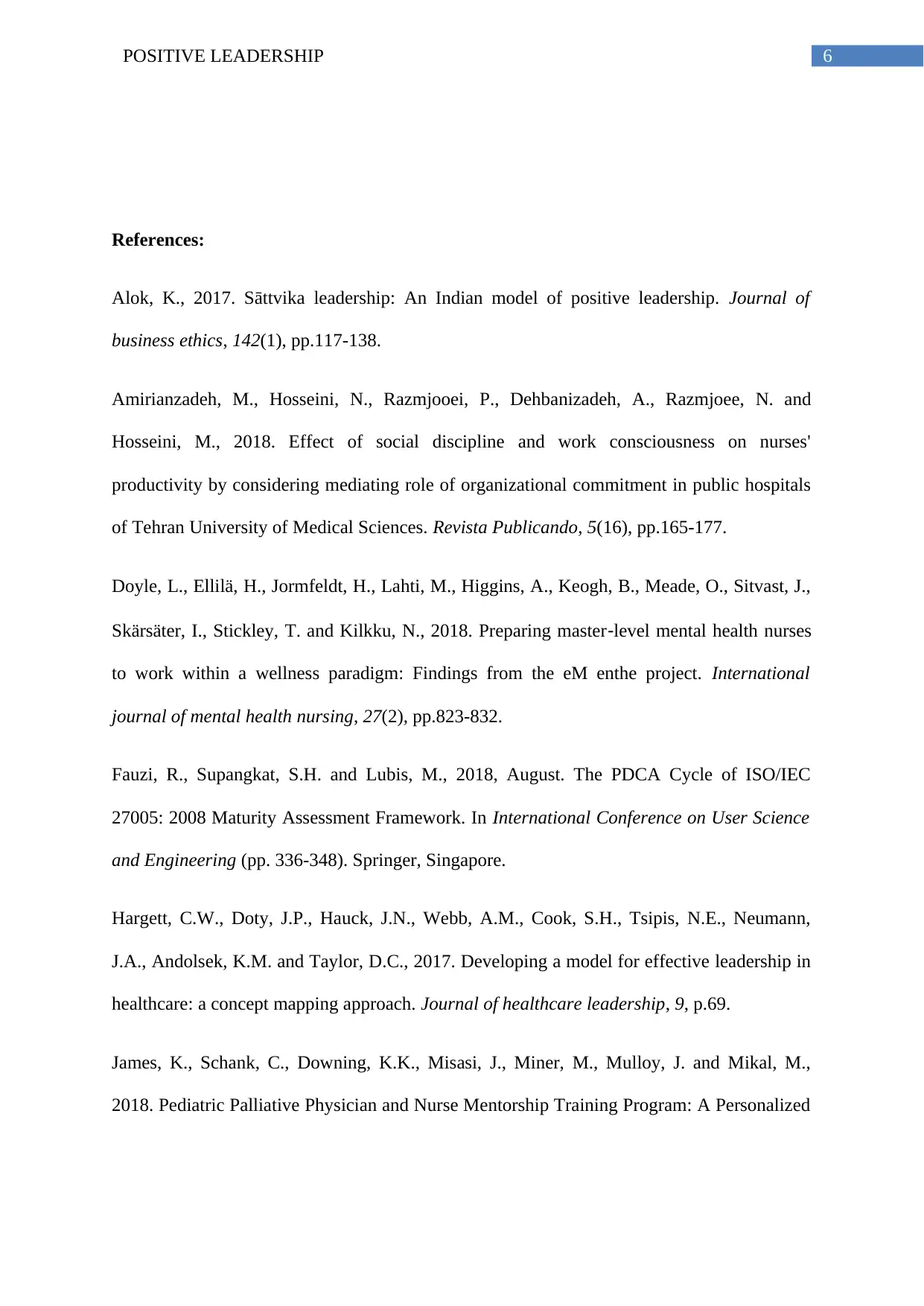
6POSITIVE LEADERSHIP
References:
Alok, K., 2017. Sāttvika leadership: An Indian model of positive leadership. Journal of
business ethics, 142(1), pp.117-138.
Amirianzadeh, M., Hosseini, N., Razmjooei, P., Dehbanizadeh, A., Razmjoee, N. and
Hosseini, M., 2018. Effect of social discipline and work consciousness on nurses'
productivity by considering mediating role of organizational commitment in public hospitals
of Tehran University of Medical Sciences. Revista Publicando, 5(16), pp.165-177.
Doyle, L., Ellilä, H., Jormfeldt, H., Lahti, M., Higgins, A., Keogh, B., Meade, O., Sitvast, J.,
Skärsäter, I., Stickley, T. and Kilkku, N., 2018. Preparing master‐level mental health nurses
to work within a wellness paradigm: Findings from the eM enthe project. International
journal of mental health nursing, 27(2), pp.823-832.
Fauzi, R., Supangkat, S.H. and Lubis, M., 2018, August. The PDCA Cycle of ISO/IEC
27005: 2008 Maturity Assessment Framework. In International Conference on User Science
and Engineering (pp. 336-348). Springer, Singapore.
Hargett, C.W., Doty, J.P., Hauck, J.N., Webb, A.M., Cook, S.H., Tsipis, N.E., Neumann,
J.A., Andolsek, K.M. and Taylor, D.C., 2017. Developing a model for effective leadership in
healthcare: a concept mapping approach. Journal of healthcare leadership, 9, p.69.
James, K., Schank, C., Downing, K.K., Misasi, J., Miner, M., Mulloy, J. and Mikal, M.,
2018. Pediatric Palliative Physician and Nurse Mentorship Training Program: A Personalized
References:
Alok, K., 2017. Sāttvika leadership: An Indian model of positive leadership. Journal of
business ethics, 142(1), pp.117-138.
Amirianzadeh, M., Hosseini, N., Razmjooei, P., Dehbanizadeh, A., Razmjoee, N. and
Hosseini, M., 2018. Effect of social discipline and work consciousness on nurses'
productivity by considering mediating role of organizational commitment in public hospitals
of Tehran University of Medical Sciences. Revista Publicando, 5(16), pp.165-177.
Doyle, L., Ellilä, H., Jormfeldt, H., Lahti, M., Higgins, A., Keogh, B., Meade, O., Sitvast, J.,
Skärsäter, I., Stickley, T. and Kilkku, N., 2018. Preparing master‐level mental health nurses
to work within a wellness paradigm: Findings from the eM enthe project. International
journal of mental health nursing, 27(2), pp.823-832.
Fauzi, R., Supangkat, S.H. and Lubis, M., 2018, August. The PDCA Cycle of ISO/IEC
27005: 2008 Maturity Assessment Framework. In International Conference on User Science
and Engineering (pp. 336-348). Springer, Singapore.
Hargett, C.W., Doty, J.P., Hauck, J.N., Webb, A.M., Cook, S.H., Tsipis, N.E., Neumann,
J.A., Andolsek, K.M. and Taylor, D.C., 2017. Developing a model for effective leadership in
healthcare: a concept mapping approach. Journal of healthcare leadership, 9, p.69.
James, K., Schank, C., Downing, K.K., Misasi, J., Miner, M., Mulloy, J. and Mikal, M.,
2018. Pediatric Palliative Physician and Nurse Mentorship Training Program: A Personalized
Paraphrase This Document
Need a fresh take? Get an instant paraphrase of this document with our AI Paraphraser
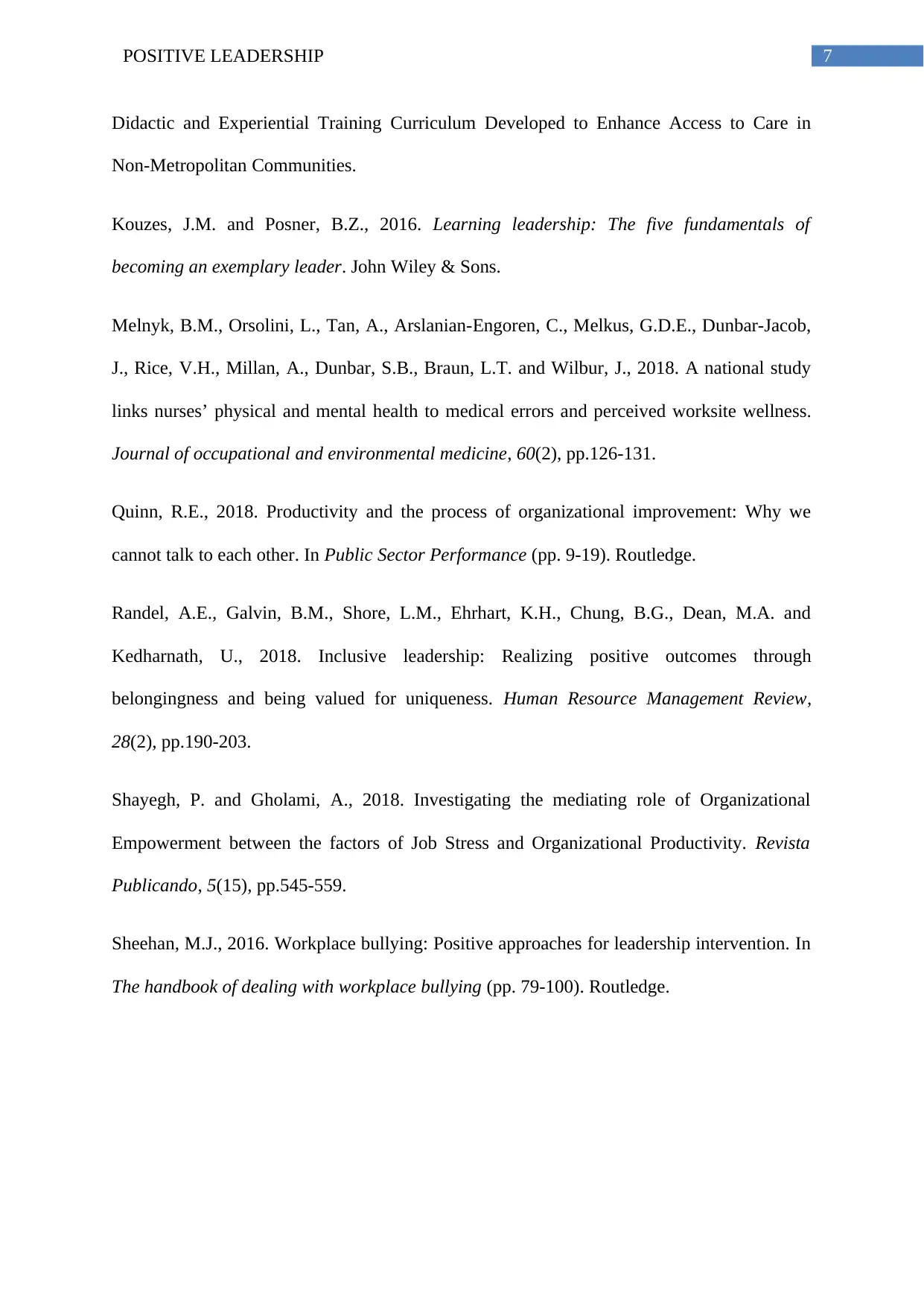
7POSITIVE LEADERSHIP
Didactic and Experiential Training Curriculum Developed to Enhance Access to Care in
Non-Metropolitan Communities.
Kouzes, J.M. and Posner, B.Z., 2016. Learning leadership: The five fundamentals of
becoming an exemplary leader. John Wiley & Sons.
Melnyk, B.M., Orsolini, L., Tan, A., Arslanian-Engoren, C., Melkus, G.D.E., Dunbar-Jacob,
J., Rice, V.H., Millan, A., Dunbar, S.B., Braun, L.T. and Wilbur, J., 2018. A national study
links nurses’ physical and mental health to medical errors and perceived worksite wellness.
Journal of occupational and environmental medicine, 60(2), pp.126-131.
Quinn, R.E., 2018. Productivity and the process of organizational improvement: Why we
cannot talk to each other. In Public Sector Performance (pp. 9-19). Routledge.
Randel, A.E., Galvin, B.M., Shore, L.M., Ehrhart, K.H., Chung, B.G., Dean, M.A. and
Kedharnath, U., 2018. Inclusive leadership: Realizing positive outcomes through
belongingness and being valued for uniqueness. Human Resource Management Review,
28(2), pp.190-203.
Shayegh, P. and Gholami, A., 2018. Investigating the mediating role of Organizational
Empowerment between the factors of Job Stress and Organizational Productivity. Revista
Publicando, 5(15), pp.545-559.
Sheehan, M.J., 2016. Workplace bullying: Positive approaches for leadership intervention. In
The handbook of dealing with workplace bullying (pp. 79-100). Routledge.
Didactic and Experiential Training Curriculum Developed to Enhance Access to Care in
Non-Metropolitan Communities.
Kouzes, J.M. and Posner, B.Z., 2016. Learning leadership: The five fundamentals of
becoming an exemplary leader. John Wiley & Sons.
Melnyk, B.M., Orsolini, L., Tan, A., Arslanian-Engoren, C., Melkus, G.D.E., Dunbar-Jacob,
J., Rice, V.H., Millan, A., Dunbar, S.B., Braun, L.T. and Wilbur, J., 2018. A national study
links nurses’ physical and mental health to medical errors and perceived worksite wellness.
Journal of occupational and environmental medicine, 60(2), pp.126-131.
Quinn, R.E., 2018. Productivity and the process of organizational improvement: Why we
cannot talk to each other. In Public Sector Performance (pp. 9-19). Routledge.
Randel, A.E., Galvin, B.M., Shore, L.M., Ehrhart, K.H., Chung, B.G., Dean, M.A. and
Kedharnath, U., 2018. Inclusive leadership: Realizing positive outcomes through
belongingness and being valued for uniqueness. Human Resource Management Review,
28(2), pp.190-203.
Shayegh, P. and Gholami, A., 2018. Investigating the mediating role of Organizational
Empowerment between the factors of Job Stress and Organizational Productivity. Revista
Publicando, 5(15), pp.545-559.
Sheehan, M.J., 2016. Workplace bullying: Positive approaches for leadership intervention. In
The handbook of dealing with workplace bullying (pp. 79-100). Routledge.

8POSITIVE LEADERSHIP
⊘ This is a preview!⊘
Do you want full access?
Subscribe today to unlock all pages.

Trusted by 1+ million students worldwide
1 out of 9
Related Documents
Your All-in-One AI-Powered Toolkit for Academic Success.
+13062052269
info@desklib.com
Available 24*7 on WhatsApp / Email
![[object Object]](/_next/static/media/star-bottom.7253800d.svg)
Unlock your academic potential
Copyright © 2020–2025 A2Z Services. All Rights Reserved. Developed and managed by ZUCOL.





